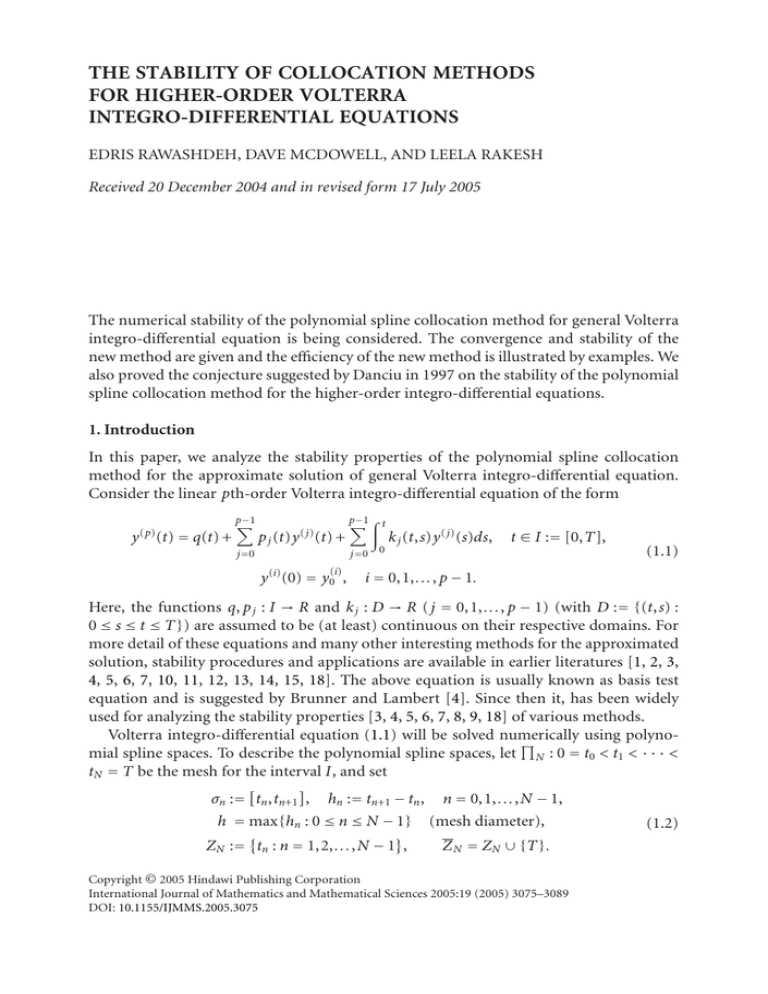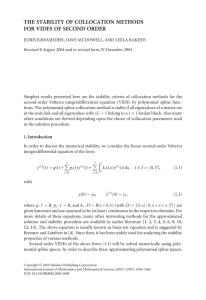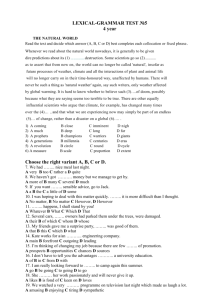THE STABILITY OF COLLOCATION METHODS FOR HIGHER-ORDER VOLTERRA INTEGRO-DIFFERENTIAL EQUATIONS
advertisement

THE STABILITY OF COLLOCATION METHODS
FOR HIGHER-ORDER VOLTERRA
INTEGRO-DIFFERENTIAL EQUATIONS
EDRIS RAWASHDEH, DAVE MCDOWELL, AND LEELA RAKESH
Received 20 December 2004 and in revised form 17 July 2005
The numerical stability of the polynomial spline collocation method for general Volterra
integro-differential equation is being considered. The convergence and stability of the
new method are given and the efficiency of the new method is illustrated by examples. We
also proved the conjecture suggested by Danciu in 1997 on the stability of the polynomial
spline collocation method for the higher-order integro-differential equations.
1. Introduction
In this paper, we analyze the stability properties of the polynomial spline collocation
method for the approximate solution of general Volterra integro-differential equation.
Consider the linear pth-order Volterra integro-differential equation of the form
p −1
y (p) (t) = q(t) +
p j (t)y ( j) (t) +
j =0
(i)
y (0) =
y0(i) ,
p −1 t
j =0 0
k j (t,s)y ( j) (s)ds,
t ∈ I := [0,T],
(1.1)
i = 0,1,..., p − 1.
Here, the functions q, p j : I → R and k j : D → R ( j = 0,1,..., p − 1) (with D := {(t,s) :
0 ≤ s ≤ t ≤ T }) are assumed to be (at least) continuous on their respective domains. For
more detail of these equations and many other interesting methods for the approximated
solution, stability procedures and applications are available in earlier literatures [1, 2, 3,
4, 5, 6, 7, 10, 11, 12, 13, 14, 15, 18]. The above equation is usually known as basis test
equation and is suggested by Brunner and Lambert [4]. Since then it, has been widely
used for analyzing the stability properties [3, 4, 5, 6, 7, 8, 9, 18] of various methods.
Volterra integro-differential equation (1.1) will be solved numerically
using polyno
mial spline spaces. To describe the polynomial spline spaces, let N : 0 = t0 < t1 < · · · <
tN = T be the mesh for the interval I, and set
σn := tn ,tn+1 ,
hn := tn+1 − tn ,
n = 0,1,...,N − 1,
h = max{hn : 0 ≤ n ≤ N − 1} (mesh diameter),
ZN := tn : n = 1,2,...,N − 1 ,
Z N = ZN ∪ {T }.
Copyright © 2005 Hindawi Publishing Corporation
International Journal of Mathematics and Mathematical Sciences 2005:19 (2005) 3075–3089
DOI: 10.1155/IJMMS.2005.3075
(1.2)
3076
Stability of the collocation method
Let πm+d be the set of (real) polynomials of degree not exceeding m + d, where m ≥ 1 and
d ≥ −1 are given integers. The solution (y) to the initial-value problem (1.1) is approximated by an element u in the polynomial spline space
S(d)
m+d (ZN ) := u := u(t)|t ∈σn := un (t) ∈ πm+d , n = 0,1,...,N − 1,
( j)
( j) un−1 tn = un tn , for j = 0,1,...,d, tn ∈ ZN .
(1.3)
It is a polynomial spline function of degree m + d, which possesses the knots ZN , and is
(−1)
d times continuously differentiable on I. If d = −1, then the elements of Sm
−1 (ZN ) may
have jump discontinuities at the knots ZN .
According to Micula [16] and Miculá and Micula [17], an element u ∈ S(d)
m+d (ZN ) for
all n = 0,1,...,N − 1 and t ∈ σn has the following form:
u(t) = un (t) =
d
u(r)
n−1 tn r!
r =0
r
t − tn +
m
an,r t − tn
d+r
,
(1.4)
r =1
where
ur−1 (0) :=
dr
u(t)
dt r
t =0
= y (r) (0),
r = 0,1,...,d.
(1.5)
From (1.4), we see that the element u ∈ S(d)
m+d (ZN ) is well defined provided the coefficients {an,r }r =1,...,m for all n = 0,1,...,N − 1 are known. In order to determine these
coefficients, we consider a set of collocation parameters {c j } j =1,...,m , where 0 < c1 < · · · <
cm ≤ 1, and define the set of collocation points as
X(N) :=
N
−1
Xn ,
with Xn := tn, j := tn + c j hn , j = 1,2,...,m .
(1.6)
n =0
The approximate solution u ∈ S(d)
m+d (ZN ) is determined by imposing the condition that
u satisfies the initial-value problem (1.1) on X(N) and the initial conditions, that is,
p −1
u(p) (t) = q(t) +
j =0
p j (t)u( j) (t) +
p −1 t
j =0 0
k j (t,s)u( j) (s)ds,
t ∈ I := [0,T], ∀t ∈ X(N),
(1.7)
with
u(i) (0) = u(i)
0 ,
i = 0,1,..., p − 1.
Here, we assume that the mesh sequence {
0,1,...,N − 1.
N}
(1.8)
is uniform, that is, hn = h, for all n =
Edris Rawashdeh et al.
3077
2. Numerical stability
In order to discuss numerical stability, we study the behavior of the method as applied to
the pth-order test Volterra integro-differential equation
p −1
y (p) (t) = q(t) +
α j y ( j) (t) + ν
t
0
j =0
y (i) (0) =
y0(i) ,
ν = 0, t ∈ I = [0,T],
y(s)ds,
(2.1)
i = 0,1,..., p − 1,
where α j , ν are constants and q : I → R is sufficiently smooth.
We refer to a polynomial spline collocation method in the space S(d)
m+d (ZN ), as an
(m,d, p)-method, where p is the order of the integro-differential equation.
Definition 2.1. An (m,d, p)-method is said to be stable if all solutions {u(tn )} remain
bounded as n → ∞, h → 0, while hN remains fixed.
From (1.4), we observe that the first d + 1 coefficients of u ∈ S(d)
m+d (ZN ) are determined
by the smooth conditions, and the exact collocation equation (1.7) can be used to determine the last m coefficients. For the convenience, we introduce the following notations:
ηn := ηn,r
r =0,...,d ,
βn := βn,r
r =1,...,m ,
with ηn,r :=
u(r)
n−1 tn
hr ,
r!
with βn,r := an,r h
d+r
(2.2)
(n = 0,1,...,N − 1).
Using (2.2) and t := tn + τh ∈ σn in (1.4), we obtain the following:
u(t) = un tn + τh =
d
ηn,r τ r +
r =0
m
βn,r τ d+r ,
∀τ ∈ (0,1], n = 0,1,...,N − 1.
(2.3)
r =1
By direct differentiation of (2.3) and using the smooth conditions of the approximation u ∈ S(d)
m+d (ZN ), we get a relationship between vector ηn+1 and vectors ηn and βn as
follows:
ηn+1 = Aηn + Bβn ,
∀n = 0,1,...,N − 1,
(2.4)
where A is the (d + 1) × (d + 1) upper triangular matrix, and B is the (d + 1) × m matrix,
whose elements are given by
a j,r
0
:= r
j
if r < j,
if r ≥ j,
d+r
.
b j,r :=
j
(2.5)
For d ≥ p, apply the collocation method to test (2.1) and use the representation (2.3)
to obtain the following collocation equation:
V βn = Wηn + h p Rn ,
for n = 0,1,...,N − 1,
(2.6)
3078
Stability of the collocation method
where V is the m × m-matrix, W is the m × (d + 1)-matrix, and Rn is the m-vector, whose
elements are given by
p −1
cd+r+1
d+r
d+r
j
d+r − p
−i
p+1
V j,r :=
p!c j
− νh
−
αi h p−i
i!cd+r
,
j
p
i
d + r + 1 i=0
W j,r
p+1
νh c j
−1
cr+1 r
p −i r
νh p+1 j +
αi h
i!crj −i
i
r + 1 i=0
:=
−1
cr+1 p
r
r−p
p+1 j
p −i r
p!c j + νh
i!crj −i
+ αi h
−
p
i
r +1
(2.7)
if r = 0,
if r = 1,2,..., p,
(2.8)
if p + 1 ≤ r ≤ d,
i =0
Rn, j
q t0, j − q t0
(p) (p) qt − qt
n, j
n−1,m + un−1 tn−1,m − un−1 tn
p −1 :=
(i) (i)
+
α
u
t
u
t
−
i
n
n
−
1,m
−
1
−
1
n
n
i=0
1
+λh u
t + τh dτ
cm
n −1
n −1
if n = 0,
(2.9)
if n > 0.
We state the following result for pth-order VIDEs which describes a stability criterion
for the collocation spline method. The proof of this theorem is similar to the proof given
by Danciu [9] for first-order VIDEs.
Theorem 2.2. An (m,d, p)-method is stable if and only if all eigenvalues of matrix M :=
A + BV −1 W are in the unit disk, and all eigenvalues with |λ| = 1 belong to a 1 × 1 Jordan
block, where the matrices A and B are defined in (2.5).
Remark 2.3. The dimension of the matrix M is dim(d + 1). Moreover, let M0 be the matrix
M with h = 0, and let λ(0) and λ be the eigenvalues of M0 and M, respectively, then it
follows that the matrix M0 has
(0)
(0)
λ(0)
1 = λ2 = · · · = λ p+1 = 1,
∀m ≥ 1, d ≥ p.
(2.10)
3. Applications
In this section, we will investigate some special cases.
(p)
(I) For the case d = p, the approximation space is Sm+p (ZN ). From the above theorem
and Remark 2.3, we have the following theorem.
Theorem 3.1. For every choice of the collocation parameters {c j } j =1,...,m , an (m, p, p)-method is stable for all m ≥ 1.
Edris Rawashdeh et al.
3079
(II) For the case m = 1, this choice of m corresponds to a classical spline function, that
is, the approximate solution u ∈ S(d)
1+d (ZN ). By Remark 2.3, M0 is the matrix M with h = 0,
(0)
and λ and λ are the respective eigenvalues of M0 and M, and we have
λ = λ(0) + O(h).
(3.1)
Lemma 3.2. If c1 ∈ (0,1] is the collocation parameter, then, for m = 1 and d ≥ p, the trace
of the matrix M0 can be computed by the following formula:
Tr M0 = d + 2 +
1
d− p+1
c1
1 d− p+1
− 1+
.
c1
(3.2)
Proof. Let V0 and W0 be the matrices V and W with h = 0, respectively. Then, for m = 1,
we have from (2.7) and (2.8) that V0 is a 1 × 1-matrix and W0 is a 1 × (d + 1)-matrix,
whose elements are given by
V0 :=
W0
d+1
d− p+1
p!c1
,
p
0
1,r
:=
if r = 0,1,..., p,
r
r−p
− p p!c1
(3.3)
if p + 1 ≤ r ≤ d.
Now, from the definition of the matrices A and B as in (2.5) (note that the diagonal
entry of the matrix A is one), we have
Tr M0 = Tr A + BV0−1 W0
1
= Tr(A) + d− p+1 Tr BW0
d+1
p p!c1
= d+1− d+1
p
d
1
d− p+1
p!c1
i= p+1
d+1
i
(3.4)
i
i− p
p!c1 .
p
However, by the binomial expansion, we have the following identity:
d
i= p+1
d+1
i
d− p+1
i
d+1
i− p
d− p+1
p!c1 =
p! 1 + c1
− 1 − c1
.
p
p
(3.5)
Hence,
Tr M0 = d + 2 +
1
d− p+1
c1
1 d− p+1
− 1+
.
c1
(3.6)
For the stability of the spline collocation method S(d)
1+d (ZN ) (m = 1), we have the following theorem.
3080
Stability of the collocation method
Theorem 3.3. A (1,d, p)-method (d ≥ p) is stable if and only if one of the following conditions is true:
(i) d = p and c1 ∈ (0,1],
(ii) d = p + 1 and c1 = 1.
Proof. For the case d = p, the conclusion follows from Theorem 3.1.
If d = p + 1, then, using (2.10) and (3.2), the p + 2-eigenvalue of M0 can be computed
as follows:
λ(0)
p+2 = Tr M0 − p − 1 = p + 3 +
1
1
− 1+
c1
c12
2
− p−1 = 1−
2
.
c1
(3.7)
Therefore, if c1 ∈ (0,1], then λ(0)
p+2 ≤ −1, and its absolute value is 1 if and only if c1 = 1.
If d ≥ p + 2, then, setting θ = d − p + 1 in (3.2), we have
Tr M0 = p − 1 + θ + 2 +
1
1
− 1+
c1
c1θ
θ
= p+θ−
i =1
If θ > 3 (i.e., d > p + 2), then, by induction, we can prove
θ(θ − 1) > 2(θ + 1).
Thus, if c1 ∈ (0,1], then
θ
−1
θ
i
θ 1
.
i c1i
(3.8)
> θ (i = 1,2,...,θ − 1) and
Tr M0 < p + θ − θ(θ − 1) < p + θ − 2(θ + 1),
(3.9)
−∞ < Tr M0 < p − θ − 2 = 2p − 3 − d.
(3.10)
and therefore
If p = 1, then from (3.10),
(0)
(0)
Tr M0 = λ(0)
1 + λ2 + · · · + λd+1 < −(d + 1),
for d > 3.
(3.11)
Therefore, there exists an eigenvalue λ(0) whose value is smaller than −1.
If p > 1, then, from (2.10) and (3.10), we have
(0)
(0)
λ(0)
p + λ p+1 + · · · + λd+1 < −(d + 2 − p),
for d > p + 2 > 3.
(3.12)
Thus, there exists an eigenvalue λ(0) whose value is less than −1.
If d = p + 2 and c1 ∈ (0,1], then, from (3.2), we have
(0)
λ(0)
p+2 + λ p+3 = Tr M0 − p − 1
1
1
− 1+
c1
c13
3
3
= 2 − − 2 ≤ −4.
c1 c1
= p+4+
3
− p−1
(3.13)
Edris Rawashdeh et al.
3081
Hence,
(0)
λ(0)
p+2 < −1 or λ p+3 < −1.
(3.14)
Thus, from Theorem 2.2, a (1,d, p)-method is unstable for any choice of the collocation
parameter c1 ∈ (0,1] when d ≥ p + 2.
(III) For the case m = 2, we can prove the following theorem. The proof is similar to
the proof given in [9] for first-order integro-differential equation (p = 1).
Theorem 3.4. Let 0 < c1 < c2 ≤ 1 be the collocation parameters, then
(i) (2, p, p)-method is stable for every choice of the collocation parameters,
(ii) (2, p + 1, p)-method is stable if and only if c1 + c2 ≥ 3/2,
(iii) if c2 = 1, then (2,d, p)-method is unstable for all d ≥ p + 2.
(p+1)
(IV) For the case d = p + 1, the approximation u ∈ Sm+p+1 (ZN ) and the dimension of
(0)
(0)
the matrix M0 are p + 2, whose λ(0)
1 = λ2 = · · · = λ p+1 = 1 are its first p + 1-eigenvalues.
To compute the p + 2-eigenvalue, we need the following results. But, first we introduce
the following notations:
m
Sk := Sk c1 ,...,cm =
ci1 ci2 · · · cik ,
for 1 ≤ k ≤ m,
1≤i1 <···<ik ≤m
(3.15)
S0 := S0 (c1 ,...,cm ) = 1,
Sk, j := Sk (c1 ,...,c j −1 ,c j+1 ,...,cm ),
for 1 ≤ k ≤ m − 1, 1 ≤ j ≤ m.
Lemma 3.5. Let 0 < c1 < c2 < · · · < cm ≤ 1 be the collocation parameters, then
1
1
.
.
.
1
c1
c2
..
.
c12
c22
..
.
cm
2
cm
c1i−1
· · · c2i−1
..
..
.
.
i −1
· · · cm
···
c1i+1
c2i+1
..
.
i+1
cm
c1m m
· · · c2m c j − ck .
= Sm−i
.. ..
.
.
1≤k< j ≤m
m
· · · cm
···
(3.16)
Proof. We will prove the lemma by induction on the dimension of the matrix, starting
with 2 × 2-matrices. For the 2 × 2-matrices, the result is clearly true. For m × m-matrices
(m > 2), we define
1
1
.
f (x) := ..
1
1
c1
c2
..
.
c12
c22
..
.
cm−1
x
2
cm
−1
x2
···
···
..
.
···
···
c1i−1
c2i−1
..
.
i−1
cm
−1
xi−1
c1i+1
c2i+1
..
.
···
i+1
cm
−1
xi+1
···
···
..
.
···
.
m cm−1 xm c1m
c2m
..
.
(3.17)
3082
Stability of the collocation method
Note that
1
1
.
.
.
1
c1
c2
..
.
c12
c22
..
.
cm
2
cm
c1i−1
· · · c2i−1
..
..
.
.
i−1
· · · cm
c1m · · · c2m = f cm .
.. ..
.
.
m
· · · cm
c1i+1
c2i+1
..
.
···
···
i+1
cm
(3.18)
Now, since f (c1 ) = f (c2 ) = · · · = f (cm−1 ) = 0, we have
m
−1
f (x) = a(x − b)
x − ci ,
(3.19)
i=1
where a, b are constants to be determined. By the induction hypothesis, we obtain
a = Sm−1−i c1 ,...,cm−1
−1
m
c j − ck .
(3.20)
k< j
Moreover, from (3.19),
f (0) = a(−1)m c1 c2 · · · cm−1 b.
(3.21)
On the other hand, from the definition of f and by the induction hypothesis, we have
c1
c2
m+1 f (0) = (−1) ..
.
cm−1
c12
c22
..
.
···
2
cm
−1
···
c1i−1
c2i−1
..
.
···
..
.
i −1
cm
−1
c1i+1
c2i+1
..
.
···
..
.
c1m
c2m
..
.
i+1
cm
−1
···
m
cm
−1
= (−1)m+1 c1 c2 · · · cm−1 Sm−i (c1 ,...,cm−1 )
m
−1
···
(3.22)
c j − ck .
k< j
Thus, from (3.21) and (3.22), we have
−1
m
−ab = Sm−i c1 ,...,cm−1
c j − ck ,
(3.23)
k< j
and so
f cm = a cm − b
−1
m
cm − ci
i =1
−1
m
c j − ck
= cm Sm−1−i c1 ,...,cm−1
k< j
+ Sm−i c1 ,...,cm−1
−1
m
c j − ck
k< j
(3.24)
−1
m
cm − ci .
i =1
Edris Rawashdeh et al.
3083
However, since
cm Sm−1−i c1 ,... ,cm−1 + Sm−i c1 ,...,cm−1 = Sm−i c1 ,...,cm = Sm−i ,
m
−1
c j − ck
−1
m
cm − ci =
m
i=1
k< j
(3.25)
c j − ck ,
k< j
we have
f cm = Sm−i
m
c j − ck ,
(3.26)
k< j
which proves the lemma.
Remark 3.6. Note that in Lemma 3.5 if i = m, then we have the Vandermonde determinant.
Corollary 3.7. Let V0 be the matrix V with h = 0 and d = p + 1, that is, V0 is the m × mmatrix, whose elements are
V0
j,r :=
p+r +1
p!cr+1
j .
p
(3.27)
Then, V0−1 is the matrix, whose elements are given by
−1
V0
1
p+k+1
(−1)r+ j S2m−1, j Sm−r, j
ck − cl
p!,
r, j =
p
det V0
l<k,(l,k= j)
k=1,(k=r)
m
m
(3.28)
where
det V0 =
m p+k+1
p
k =1
Proof. From Lemma 3.5, we have det(V0 ) = [
V0
ck − cl
S2m .
(3.29)
l<k
m p+k+1
k =1
−1
p!
m
p
p!
m
l<k (ck
− cl )]S2m . Now,
Adj V0
,
=
det V0
(3.30)
3084
Stability of the collocation method
where Adj(V0 ) is the adjoint matrix of V0 , however,
Adj
V0 r, j = (−1)r+ j S2m−1, j
1
1
.
.
.
× 1
1
.
.
.
1
m
k=1,(k=r)
p+k+1
p!
p
crj −1
crj+1
..
.
···
..
.
−2
crj+1
..
.
···
r −2
cm
r
cm
···
c12
c22
..
.
c j −1
c2j −1
c j+1
..
.
c2j+1
..
.
···
cm
2
cm
c1r
c2r
..
.
···
c1m−1 · · · c2m−1 .. ..
. .
m−1 · · · c j −1 .
c1r −2
· · · c2r −2
..
..
.
.
r −2
· · · c j −1
c1
c2
..
.
···
..
.
(3.31)
−1 cmj+1
.. . m−1 cm
Again, by Lemma 3.5 and using the following relations:
Sm−1−(r −1) c1 ,...,c j −1 ,c j+1 ,...,cm = Sm−r c1 ,... ,c j −1 ,c j+1 ,...,cm = Sm−r, j ,
(3.32)
we have
1
1
.
.
.
1
1
.
.
.
1
c2j −1
c1r −2
· · · c2r −2
..
..
.
.
−2
· · · crj −
1
crj −1
c2j+1
−2
crj+1
crj+1
c1
c2
..
.
c12
c22
..
.
c j −1
c j+1
..
.
···
..
.
2
cm
cm
···
..
.
···
..
.
r −2
cm
c1r
c2r
..
.
..
.
r
cm
c1m−1 · · · c2m−1 ..
.. .
. m−1 · · · c j −1 = Sm−r, j
···
···
..
.
···
−1 cmj+1
.. . m−1 cm
m
ck − cl .
(3.33)
l<k,(l,k= j)
Thus,
V0−1
r, j
=
1
p+k+1
(−1)r+ j S2m−1, j Sm−r, j
ck − cl
p!,
p
det V0
l<k,(l,k= j)
k=1,(k=r)
m
m
(3.34)
which completes the proof of the corollary.
Now, we can develop a formula for computing the p + 2-eigenvalue of the matrix M0 .
Theorem 3.8. For the case d = p + 1 and m ≥ 1, the p + 2-eigenvalue of M0 can be computed by using the following relation:
λ(0)
p+2 =
Sm − 2Sm−1 + 3Sm−2 + · · · + (−1)m−1 mS1 + (−1)m (m + 1)
.
Sm
(3.35)
Edris Rawashdeh et al.
3085
Proof. Let V0 and W0 be the matrices V and W, respectively, with h = 0, then for d= p + 2,
we have from (2.8) that W0 is a m × (p + 2)-matrix, whose elements are given by
W0
0
j,r
if r = 0,1,..., p,
if r = p + 1.
:=
−(p + 1)!c j
(3.36)
Now, the p + 2th-eigenvalue of M0 = A + BV0−1 W0 is
λ(0)
p+2 = 1 +
m
(B) p+2,r V0−1 W0
r =1
r,p+2 .
(3.37)
The entries of the last row of matrix B are
p+r +1
(B) p+2,r =
.
p+1
(3.38)
Moreover, from (3.36) and Corollary 3.7, we have
−1
V0
m −(p + 1)! W0 r,p+2 =
(−1)(r+ j) S2m−1, j Sm−r, j c j
det V0
j =1
×
m
ck − cl
l<k,(l,k= j)
m
k=1,(k=r)
p+k+1
p! .
p
(3.39)
Therefore,
λ(0)
p+2
m m
(p + 1)! = 1+
det V0 r =1 j =1
p+r +1
(−1)(r+ j+1) S2m−1, j Sm−r, j c j
p+1
m
×
ck − cl
l<k,(l,k= j)
m
k=1,(k=r)
(3.40)
p+k+1
p! .
p
Now, by using the relations
c j S2m−1, j = Sm Sm−1, j ,
p+r +1
(p + 1)!
p+1
m
k=1,(k=r)
p+k+1
p+k+1
p! = (r + 1)
p!,
p
p
k =1
m
(3.41)
and by substituting (3.29) for det(V0 ), (3.40) can be simplified as follows:
m
λ(0)
p+2
= 1+
r =1 (−1)
r (r
+ 1)
m
j =1 (−1)
( j+1) S
m−1, j Sm−r, j
m Sm l<k ck − cl
m
l<k,(l,k= j)
ck − cl
.
(3.42)
3086
Stability of the collocation method
However, from Lemma 3.5, we have
1
m
1
(−1)( j+1) Sm−1, j Sm−r, j
ck − cl = ..
.
j =1
l<k,(l,k= j)
1
= Sm−r
c1
c2
..
.
c12
c22
..
.
cm
2
cm
m
c1r −1
· · · c2r −1
..
..
.
.
r −1
· · · cm
···
c1r+1
c2r+1
..
.
r+1
cm
c1m · · · c2m .. ..
.
.
m
· · · cm ···
ck − cl .
l<k
(3.43)
Hence,
λ(0)
p+2
m
r =1 (−1)
r (r
+ 1)Sm−r
Sm
(−1)r (r + 1)Sm−r
= r =0
Sm
Sm − 2Sm−1 + 3Sm−2 + · · · + (−1)m−1 mS1 + (−1)m (m + 1)
=
,
Sm
= 1+
m
(3.44)
which concludes the proof of Theorem 3.8.
Remark 3.9. Theorem 3.8 proves the conjecture asserted by Danciu [9] for first-order
integro-differential equations (p = 1,d = 2).
As an application to Theorem 3.8, we can prove the following results. The proofs are
identical to the proof given in [9] for the first-order integro-differential equation.
Corollary 3.10. An (m, p + 1, p)-method is stable if and only if
(d/dt)t · R (t) m
t =1 ≤ 1,
Rm (0)
(3.45)
where Rm (t) is the polynomial of degree m, whose zeroes are the collocation parameters
{c j } j =1,...,m .
(p+1)
Regarding the stability of local superconvergent solution u ∈ Sm+p+1 (Zn ), we have the
following corollary.
Corollary 3.11. (i) If the collocation parameters {c j } j =1,...,m are uniformly distributed in
(0,1] (i.e., c j = j/m, for all j = 1,2,...,m), then (m, p + 1, p)-method is stable for m ≥ 1.
(ii) If the collocation parameters {c j } j =1,...,m are the Radau II points in the interval (0,1],
then (m, p + 1, p)-method is unstable for m ≥ 2.
(iii) If the collocation parameters {c j } j =1,...,m are the Gauss points in the interval (0,1],
then (m, p + 1, p)-method is unstable for m ≥ 2.
(iv) If the first m − 1 collocation parameters {c j } j =1,...,m are the Gauss points in the interval (0,1) and the last collocation parameter is cm = 1, then (m, p + 1, p)-method is stable for
m ≥ 2.
Edris Rawashdeh et al.
3087
√
√
Table 4.1. Approximate error for Example 4.1 with c1 = (5 − 15)/10, c2 = 1/2, c3 = (5 + 15)/10.
d
e1
eN/2
eN
d=3
d=4
d=5
2.70 × 10−10
2.70 × 10−10
2.70 × 10−10
3.31 × 10−4
2.61 × 1023
4.58 × 1049
6.54 × 10−3
5.97 × 1058
4.25 × 10113
√
√
Table 4.2. Approximate error for Example 4.2 with c1 = (5 − 15)/10, c2 = 1/2, c3 = (5 + 15)/10.
d
e1
d=4
d=5
d=6
eN/2
eN
−5
1.07 × 10−3
3.32 × 1056
1.02 × 10112
2.91 × 10
1.45 × 1021
1.20 × 1048
0
0
0
4. Numerical examples
The method is tested using the following two examples in the interval [0,1] with step size
h = 0.05, errors are computed in Tables 4.1 and 4.2 for various (3,d, p)-methods with
p = 3,4. The following notations will also be used in the presentation:
e1 := y t1 − u t1 ,
eN/2 := y(0.5) − u(0.5),
eN := y(1) − u(1),
(4.1)
where u ∈ Sd3+d (m = 3) is the approximated solution.
Example 4.1. Consider the following integro-differential equation of third order:
y (3) (t) =
t
0
y(s)ds,
y(0) = 1, y (0) = 2, y (0) = 1,
(4.2)
with exact solution y(t) = et + sint.
Example 4.2. Consider the following fourth-order integro-differential equation:
y (4) (t) = 1 +
t
0
y(s)ds,
y(0) = y (0) = y (0) = y (3) (0) = 1,
(4.3)
with exact solution y(t) = et .
(a) Let us consider the Gauss√points as the collocation parameters, that is, c1 = (5 −
15)/10, c2 = 1/2, and c3 = (5 + 15)/10, then we have Tables 4.1 and 4.2 corresponding
to Examples 4.1 and 4.2, respectively.
√
(b) If the
√ first two collocation parameters are the Gauss points, that is, c1 = (3 − 3)/6,
c2 = (3 + 3)/6, and c3 = 1, then we have Tables 4.3 and 4.4 for Examples 4.1 and 4.2.
From Tables 4.3 and 4.4, one can observe that (3,d, p)-method (p = 3,4) is stable for
is stable if the
first
d = p and it is unstable for d = p + 2. In the case d = p + 1, this method
√
√
two collocation parameters are the Gauss points, that is, c1 = (3 − 3)/6, c2 = (3 + 3)/6,
√
3088
Stability of the collocation method
√
√
Table 4.3. Approximate error for Example 4.1 with c1 = (3 − 3)/6, c2 = (3 + 3)/6, c3 = 1.
d
e1
d=3
d=4
d=5
eN/2
−10
2.70 × 10
2.70 × 10−10
2.70 × 10−10
eN
−10
4.20 × 10−9
5.20 × 10−9
4.53 × 1040
6.00 × 10
4.00 × 10−10
3.95 × 1010
√
√
Table 4.4. Approximate error for Example 4.2 with c1 = (3 − 3)/6, c2 = (3 + 3)/6, c3 = 1.
d
e1
d=4
d=5
d=6
0
0
0
eN/2
eN
−9
5.00 × 10
5.00 × 10−9
4.99 × 107
1.00 × 10−8
1.40 × 10−8
5.73 × 1037
and c3 = 1 as in case
(b), and unstable if the collocation
parameters are the Gauss points,
√
√
that is, c1 = (5 − 15)/10, c2 = 1/2, and c3 = (5 + 15)/10 as in case (a).
References
[1]
[2]
[3]
[4]
[5]
[6]
[7]
[8]
[9]
[10]
[11]
[12]
[13]
H. Brunner, A survey of recent advances in the numerical treatment of Volterra integral and
integro-differential equations, J. Comput. Appl. Math. 8 (1982), no. 3, 213–229.
, Implicit Runge-Kutta methods of optimal order for Volterra integro-differential equations, Math. Comp. 42 (1984), no. 165, 95–109.
, The approximate solution of initial-value problems for general Volterra integro-differential equations, Computing 40 (1988), no. 2, 125–137.
H. Brunner and J. D. Lambert, Stability of numerical methods for Volterra integro-differential
equations, Computing (Arch. Elektron. Rechnen) 12 (1974), no. 1, 75–89.
H. Brunner, A. Pedas, and G. Vainikko, Piecewise polynomial collocation methods for linear
Volterra integro-differential equations with weakly singular kernels, SIAM J. Numer. Anal.
39 (2001), no. 3, 957–982.
H. Brunner and P. J. van der Houwen, The Numerical Solution of Volterra Equations, CWI
Monographs, vol. 3, North-Holland, Amsterdam, 1986.
T. A. Burton, Volterra Integral and Differential Equations, Mathematics in Science and Engineering, vol. 167, Academic Press, Florida, 1983.
I. Danciu, Polynomial spline collocation methods for Volterra integro-differential equations, Rev.
Anal. Numér. Théor. Approx. 25 (1996), no. 1-2, 77–91.
, Numerical stability of collocation methods for Volterra integro-differential equations,
Rev. Anal. Numér. Théor. Approx. 26 (1997), no. 1-2, 59–74.
A. Goldfine, Taylor series methods for the solution of Volterra integral and integro-differential
equations, Math. Comp. 31 (1977), no. 139, 691–707.
T. Lin, Y. Lin, M. Rao, and S. Zhang, Petrov-Galerkin methods for linear Volterra integrodifferential equations, SIAM J. Numer. Anal. 38 (2000), no. 3, 937–963.
F. R. Loscalzo, An introduction to the application of spline functions to initial value problems, Theory and Applications of Spline Functions (Proceedings of Seminar, Math. Research Center,
Univ. of Wisconsin, Madison, Wis., 1968) (T. N. E. Greville, ed.), Academic Press, New York,
1969, pp. 37–64.
F. R. Loscalzo and T. D. Talbot, Spline function approximations for solutions of ordinary differential equations, SIAM J. Numer. Anal. 4 (1967), no. 3, 433–445.
Edris Rawashdeh et al.
[14]
[15]
[16]
[17]
[18]
3089
R. C. MacCamy, A model for one-dimensional, nonlinear viscoelasticity, Quart. Appl. Math. 35
(1977/78), no. 1, 21–33.
, An integro-differential equation with application in heat flow, Quart. Appl. Math. 35
(1977/78), no. 1, 1–19.
G. Micula, Approximate solution of the differential equation y = f (x, y) with spline functions,
Math. Comp. 27 (1973), 807–816.
M. Miculá and G. Micula, Sur la résolution numérique des équations intégrales du type de Volterra
de seconde espèce à l’aide des fonctions splines, Studia Univ. Babeş-Bolyai Ser. Math.-Mech.
18 (1973), no. 2, 65–68 (French).
V. Volterra, Theory of Functionals and of Integral and Integro-Differential Equations, Dover, New
York, 1959.
Edris Rawashdeh: Department of Mathematics, Center for Applied Mathematics and Polymer
Fluid Dynamics, Central Michigan University, Mt. Pleasant, MI 48859, USA
E-mail address: edris@yu.edu.jo
Dave McDowell: Department of Mathematics, Center for Applied Mathematics and Polymer Fluid
Dynamics, Central Michigan University, Mt. Pleasant, MI 48859, USA
E-mail address: McDow1D@cmich.edu
Leela Rakesh: Department of Mathematics, Center for Applied Mathematics and Polymer Fluid
Dynamics, Central Michigan University, Mt. Pleasant, MI 48859, USA
E-mail address: leela.rakesh@cmich.edu








